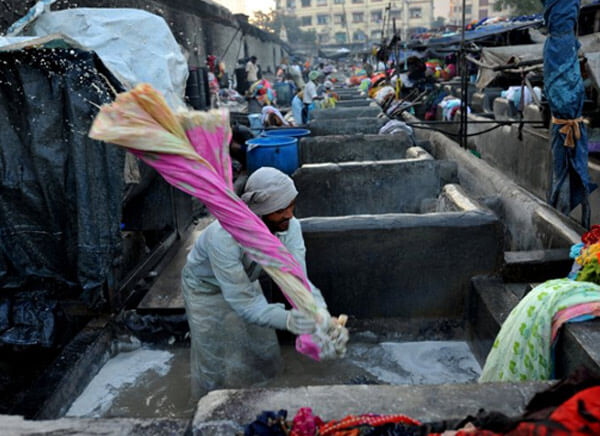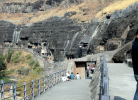Mahalaxmi Dhobi Ghat - Entered Guinness Book Of Records
Visitor Information:

-
Famous For Seeking Experience, Photography
-
Fee 4:30 AM to 10:00 PM on all days of the week
-
Visiting Time 11:00 AM to 6:00 PM on all days of the week except Sunday
-
Duration of Visit 4 to 5 hours
Dhobhi Ghat of Mumbai is situated in the heart of Mahalaxmi, Mumbai. This Ghat is World famous for its rich history, movies shot here and for being the World’s largest outdoor laundry. Dhobi Ghat can be seen from the flyover of Mahalaxmi Ghat.
One can see Washer-men, known as Dhobis in India, here up awake from very early in the morning. They start doing their work at 4:30 A.M. work until the 10:00PM. One can see numerous men and women washing clothes in the big sinks by hands. And this has been going on for centuries.
At this Dhobi Ghat you will find these men and women wash clothes considerably of half of the population of the Mumbai. And still ensuring the right clothes reach the right customer.
These Dhobis work for organizations like hotels and hospitals as well and known for their punctuality and great organizing skills.
History of Dhobi Ghat
It was founded by an association of washer-men 140 years ago.
But the place has changed with time. This is the one of the few organizations and destinations in Mumbai whose name is still the same. It was initiated in the Victorian Era and still has its own name- “Dhobi Ghat” which means a place where washer men cleans clothes and dries them.
In its early days the Ghat had two different systems for washing and soaking but in the days of 1890 to 1895, washer men figured out a huge increment in population and their industry. Then they managed to do the both things at the same time. The stones used for washing here are from the beginning of time.
But in the Era of British ruling, those stones were used to manage the outflow of polluted water, in order to save some.
The Washer-Men and Women
There are more than 800 families living in two floors of the chawl system here. Despite of the growth in India, these people still use the same way to wash the clothes as they were using for ages. They use flogging stones, brush caustic soda and tons of water.
A regular person working here earns in between 300-500 Rupees a day, however a maximum of nearly 800 Rupees a day.
Every single stone is owned by a few families. On 731 stones, 4 to 5 thousand people have their lives depending on. If these Dhobis let technology enlighten them then one can see machines here with the washing-drying happening automatically.
However that would make the authenticity and history of this place diminish.
Services
This is the second most known important labour organization after the Dabbawallas in Mumbai. Like Dabbawalla, this community also remained loyal and punctual to its customer base. They changed but not in ethics and have only improved their quality of work by adopting machinery.
Each family is allotted with a number of customers and they don’t try to cut down others business here. They never show any interest in such kind of interest. They also divided their man power according to skills.
Some of them are well skilled in drying and other ones are in washing. They arrange their team accordingly.
Government Contribution
During the time when the city was known as Bombay, the State government gave these Washer- men 38 acres of land so they could maintain their service for big hospitals, hotels and other organizations.
But the community had to pay 400 Rs to the government in return of that land and for the free water supply at the ghat.
Service Quality
No matter what happens if one gives them their clothes, they are sure to receive them properly ironed and on the address at the exact time mentioned.
Every person working here shows their respect to the ethics of this organization and does whatever it demands to deliver their work on time.
In Bollywood Movies
From songs to movies, from national news to international headlines, the area remains in limelight. Many Bollywood movies including Munna Bhai MBBS, Satya, Virasat and the famous movie starred Amir khan- Dhobhi Ghat was also shot here.
How to Reach Dhobi Ghat
These clothes are usually picked up by some members of this clan and are transported by local trains to this Dhobi Ghat for washing. If one is keen on having a glimpse of this place, then one can take the following route mentioned below.
One should get just get to the Mahalaxmi station on the Western line.
After walking out from the station, one needs to take a left.
You will find a flyover which will take you to Saat Rasta, and thereafter you would arrive at Dhobi Ghat. One would be amazed to see those endless rows of concrete in which wash pans and flogging stones are fitted.
The view is spectacular, and anyone traveling to India and visiting Mumbai, should definitely visit this place for an amazing experience.
Best Time To Visit Dhobi Ghat
The best time to visit this place is between October and March as the humidity level in air is less than the rest months around the year.
The scorching heat of Mumbai can be extremely harsh to anyone who doesn’t have an experience, hence planning a trip during the months suggest will be ideal.
Entry Fee of Dhobi Ghat
There is no entree but if you want detailed information about the area then you should hire a guide which will charge you 100-200 Rs.
Conclusion
As we noted above. the organization have strong ethics and the best service quality. Regardless of the extensive nature of their business, they earn profitably.
Over the time they adopted technology and have changed their work culture too.
One should gain inspiration from their dedication, teamwork and their organizational ethics.























